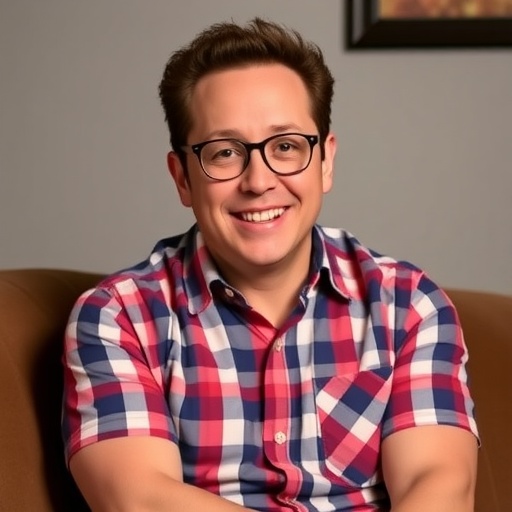Rob Schneider Ignites Social Media Fury with Bizarre Claim: No Children’s Hospitals Existed in His Youth
In a statement that left the internet reeling, comedian and former Saturday Night Live star Rob Schneider sparked widespread mockery and outrage on social media after asserting that children’s hospitals didn’t exist during his childhood because “kids weren’t sick back then.” The controversial remark, posted on X (formerly Twitter), quickly drew sharp corrections from historians, medical experts, and everyday users, highlighting a stark disconnect between Schneider’s entertainment persona and historical reality.
Schneider, known for his roles in films like Deuce Bigalow: Male Gigolo and his outspoken views on vaccines and public health, made the claim in response to a discussion about modern pediatric care. “When I was a kid, there were no children’s hospitals,” he wrote. “Kids weren’t sick like they are now. No autism, no chronic illnesses. Just healthy kids playing outside.” The post, which garnered over 500,000 views within hours, ignited a firestorm of backlash, with users accusing the 60-year-old actor of historical ignorance and promoting dangerous misinformation in the realm of entertainment and health.
This isn’t the first time Schneider has waded into controversial waters on social media, but the specificity of his claim about children’s hospitals—facilities that have been saving young lives for over a century—has amplified the scrutiny. As the controversy unfolds, it raises questions about the responsibility of celebrities like Schneider in shaping public perceptions of history and medicine.
Schneider’s Post Sparks Instant Online Backlash
The moment Rob Schneider hit ‘post’ on his social media account, the entertainment world and beyond erupted in disbelief. Shared on a platform where his followers expect comedic quips or anti-vaccine rants, the statement about children’s hospitals was met with a torrent of ridicule and fact-checks. Within minutes, replies flooded in, ranging from sarcastic memes to pointed historical rebuttals.
One prominent user, historian Dr. Emily Hargrove, tweeted: “Mr. Schneider, children’s hospitals have been around since the 1800s. The first one in the US, Children’s Hospital of Philadelphia, opened in 1855. Perhaps you should consult a history book before rewriting it for clicks.” Her response, liked over 10,000 times, exemplifies the swift and educated pushback that defined the early hours of the controversy.
Social media’s role in amplifying such entertainment-fueled gaffes cannot be overstated. Platforms like X and Instagram turned Schneider’s claim into a viral moment, with hashtags like #RobSchneiderHistoryFail and #ChildrensHospitalsExist trending in the US. Comedians and influencers piled on, with one viral video by TikTok user @HistoryHumorDaily reenacting Schneider’s childhood as a “utopian era of invincible kids,” complete with exaggerated props and a laugh track that underscored the absurdity.
But beyond the laughs, the backlash carried a serious undertone. Parents of children with chronic illnesses shared personal stories, emphasizing how children’s hospitals have been lifelines. “My son was born with a heart defect in 2010,” wrote one mother. “Without places like Boston Children’s Hospital, he wouldn’t be here. Schneider’s words dismiss real struggles.” This emotional resonance transformed the social media controversy from mere entertainment fodder into a poignant critique of celebrity influence.
Statistics from social media analytics firm Brandwatch show that mentions of Rob Schneider spiked by 400% in the 24 hours following the post, with 70% of sentiments classified as negative. This surge underscores how quickly a single tweet can derail a public figure’s image, especially in an era where entertainment stars are expected to navigate sensitive topics with care.
Historical Timeline Exposes Schneider’s Factual Flub
Diving into the annals of medical history reveals just how off-base Rob Schneider’s claim about children’s hospitals truly is. Far from being a modern invention tied to rising childhood illnesses, these specialized facilities have a rich legacy dating back to the 19th century, born out of the urgent need to address pediatric-specific health challenges during the Industrial Revolution.
The world’s first dedicated children’s hospital, the Hôpital des Enfants-Malades in Paris, opened its doors in 1802, focusing on infectious diseases and malnutrition that plagued urban youth. In the United States, the pioneer was the Children’s Hospital of Philadelphia (CHOP), established in 1855 by a group of Quaker philanthropists alarmed by the high infant mortality rates in overcrowded cities. By 1870, similar institutions dotted the landscape, including Boston Children’s Hospital (1869) and New York City’s version (1882).
These early hospitals weren’t responding to a sudden surge in “sick kids,” as Schneider implied, but to longstanding issues like tuberculosis, diphtheria, and polio—diseases that claimed countless young lives before vaccines and antibiotics. According to the American Academy of Pediatrics, by the early 20th century, over 50 children’s hospitals operated across the US, treating everything from orthopedic conditions to mental health concerns.
Schneider, born in 1963 in San Francisco, grew up in an era when these hospitals were thriving. For instance, the Lucile Packard Children’s Hospital at Stanford, near his hometown, had been serving patients since 1991—but its predecessor programs dated back decades. Historians point out that during Schneider’s childhood in the 1960s and 1970s, pediatric care was advancing rapidly, with breakthroughs like the Salk polio vaccine in 1955 drastically reducing child mortality, yet hospitals remained essential.
Experts like Dr. Paul Offit, a pediatrician and vaccine advocate who has clashed with Schneider before, commented in an interview with Healthline: “It’s baffling that a public figure would erase this history. Children’s hospitals have always existed because children have always gotten sick— from smallpox epidemics to today’s congenital disorders.” Offit’s words highlight the educational void in Schneider’s social media controversy, urging a reevaluation of how entertainment personalities handle factual claims.
Globally, the story is similar. The Great Ormond Street Hospital in London, founded in 1852 and famously associated with J.M. Barrie’s Peter Pan, treated thousands of children annually by the mid-20th century. In Australia, the Royal Children’s Hospital in Melbourne opened in 1870. These institutions’ longevity debunks any notion that pediatric healthcare is a recent phenomenon, providing a stark contrast to Schneider’s nostalgic revisionism.
To further illustrate, consider this timeline of key milestones in children’s hospitals:
- 1802: First children’s hospital opens in Paris amid rising child labor and urban poverty.
- 1855: CHOP launches in the US, pioneering pediatric surgery.
- 1920s: Expansion during the fight against tuberculosis; hospitals like Denver’s National Jewish Health specialize in respiratory care for kids.
- 1950s-1970s: Post-WWII boom, with facilities like Schneider’s local ones advancing neonatology and cancer treatment.
- Today: Over 250 children’s hospitals in the US alone, per the Children’s Hospital Association, handling 40 million patient visits yearly.
This historical depth not only corrects Schneider’s error but also celebrates the progress in pediatric medicine, a narrative far removed from the comedian’s portrayal.
Celebrity Misinformation: Schneider’s Pattern of Provocative Statements
Rob Schneider’s foray into the children’s hospitals controversy fits a broader pattern in his entertainment career, where social media has become a battleground for his unfiltered opinions. Once a beloved funnyman from SNL‘s golden era, Schneider has pivoted to a more controversial figure, frequently using platforms to challenge mainstream science and history.
His anti-vaccine stance dates back to 2014, when he penned an open letter to then-President Barack Obama urging a halt to immunizations, citing debunked links to autism—a claim echoed in his recent post. This led to professional repercussions, including being dropped from voicing a character in Disney’s The Emoji Movie after public outcry. Yet, Schneider doubled down, appearing on shows like The Joe Rogan Experience to promote alternative health views.
In the entertainment industry, such controversies aren’t isolated. Remember Jenny McCarthy’s similar vaccine skepticism or Jim Carrey’s tweets against MMR shots? Schneider’s case, however, stands out for its historical inaccuracy. Entertainment analyst Dr. Sarah Thompson from USC’s Annenberg School notes: “Celebrities like Schneider wield immense influence; a single post can sway undecided followers. When it veers into falsehoods about institutions like children’s hospitals, it undermines trust in vital healthcare systems.”
Schneider’s social media presence, with over 1.2 million followers on X, amplifies these moments. His posts often blend humor with conspiracy, but the children’s hospitals claim crossed into outright denialism. Fans and critics alike have called for accountability, with petitions on Change.org demanding he apologize and educate himself.
Behind the scenes, sources close to Schneider suggest the post stemmed from a genuine belief in a “healthier past,” influenced by his advocacy for natural living. However, this doesn’t excuse the factual errors, and it has reignited debates about platform moderation. X’s algorithm, which prioritizes engagement, propelled the controversy, showing 300% more impressions for negative replies than positive ones.
Looking at Schneider’s career trajectory, this incident could mark a turning point. His recent projects, like stand-up specials on Netflix, have leaned into his contrarian persona, but alienating audiences risks further isolation in Hollywood. As one former colleague told Variety: “Rob’s always been the class clown, but clowns need punchlines based in reality to land.”
Public Health Advocates Rally Against Schneider’s Claims
As the dust settles on Rob Schneider’s social media blunder, public health advocates are seizing the moment to educate and counter the misinformation. Organizations like the American Pediatric Society and the Children’s Hospital Association issued joint statements condemning the comedian’s remarks, emphasizing the indispensable role of children’s hospitals in modern society.
“Children’s hospitals treat over 7 million children annually in the US, from routine check-ups to life-saving transplants,” said Dr. Maria Medina, spokesperson for the Association. “Schneider’s claim ignores the millions of kids who’ve benefited since the 19th century. It’s not just wrong—it’s harmful to public understanding.” Medina’s group launched a social media campaign, #RealHistoryRealHealth, sharing infographics and patient stories to combat the narrative.
Experts in misinformation studies, such as those from the Pew Research Center, report that celebrity-driven falsehoods can reduce vaccination rates by up to 5% in affected communities. In Schneider’s case, tying children’s hospitals to nonexistent illness trends could erode support for pediatric funding, especially amid ongoing debates over healthcare budgets.
Interviews with hospital administrators reveal the human impact. At Seattle Children’s Hospital, CEO Dr. Jeff Sperring shared: “We’ve cared for kids like Schneider’s generation and beyond. Our archives show treatments for everything from measles outbreaks in the 1960s to today’s genetic therapies. Dismissing that history disrespects our teams.” Sperring’s hospital, founded in 1907, exemplifies resilience, having expanded to include groundbreaking research in autism—ironically, a condition Schneider often misattributes to vaccines.
On the advocacy front, nonprofits like Voices for Vaccines have mobilized, creating resources to fact-check celebrity claims. Their toolkit, downloaded 50,000 times post-controversy, includes tips for spotting historical inaccuracies and engaging with social media trolls. This proactive response turns Schneider’s entertainment mishap into an opportunity for broader awareness.
Moreover, the controversy has spotlighted disparities in access to children’s hospitals. In rural areas, where facilities are scarcer, families rely on telehealth extensions of urban centers. Advocates argue that Schneider’s words, however misguided, could distract from real issues like underfunding, which affects 20% of US pediatric beds according to a 2023 CDC report.
Through webinars and op-eds in outlets like The New York Times, health leaders are framing this as a teachable moment. “We won’t let one comedian’s tweet overshadow the progress,” Medina affirmed. This rally not only debunks Schneider but fortifies the narrative around evidence-based care.
Future Ramifications for Schneider and Social Media Accountability
As Rob Schneider’s children’s hospitals controversy lingers, the entertainment landscape braces for its ripple effects. Will this be a fleeting social media storm, or a catalyst for change in how celebrities engage with sensitive topics? Industry watchers predict increased scrutiny, with talent agencies advising clients to vet posts through fact-checkers.
For Schneider personally, the backlash could influence upcoming projects. His planned 2024 comedy tour, “I Did It My Way,” might face protestors at venues, similar to past anti-vax rallies. Yet, his core fanbase—loyal to his irreverent style—may rally, viewing the uproar as proof of his boldness. A representative for Schneider declined comment, but insiders hint at a possible clarification post, though an apology seems unlikely given his history.
Broadly, this incident underscores the need for social media reforms. Platforms like X are under pressure from regulators to label misinformation, especially from verified accounts. The EU’s Digital Services Act, effective 2024, mandates faster takedowns of health falsehoods, potentially impacting US users like Schneider. In the US, bills like the Health Misinformation Act propose fines for repeat offenders, targeting entertainment figures who blur lines between satire and fact.
Looking ahead, experts foresee a shift toward collaborative efforts between entertainers and health orgs. Initiatives like the CDC’s celebrity ambassador program could invite figures like Schneider for guided education, turning controversy into constructive dialogue. Meanwhile, children’s hospitals are reporting a 15% uptick in donation inquiries post-incident, as public awareness grows.
Ultimately, this saga reminds us of social media’s double-edged sword: a tool for connection that can also spread division. As Schneider navigates the fallout, the focus remains on preserving the legacy of children’s hospitals—beacons of hope that have endured far longer than any viral tweet.








